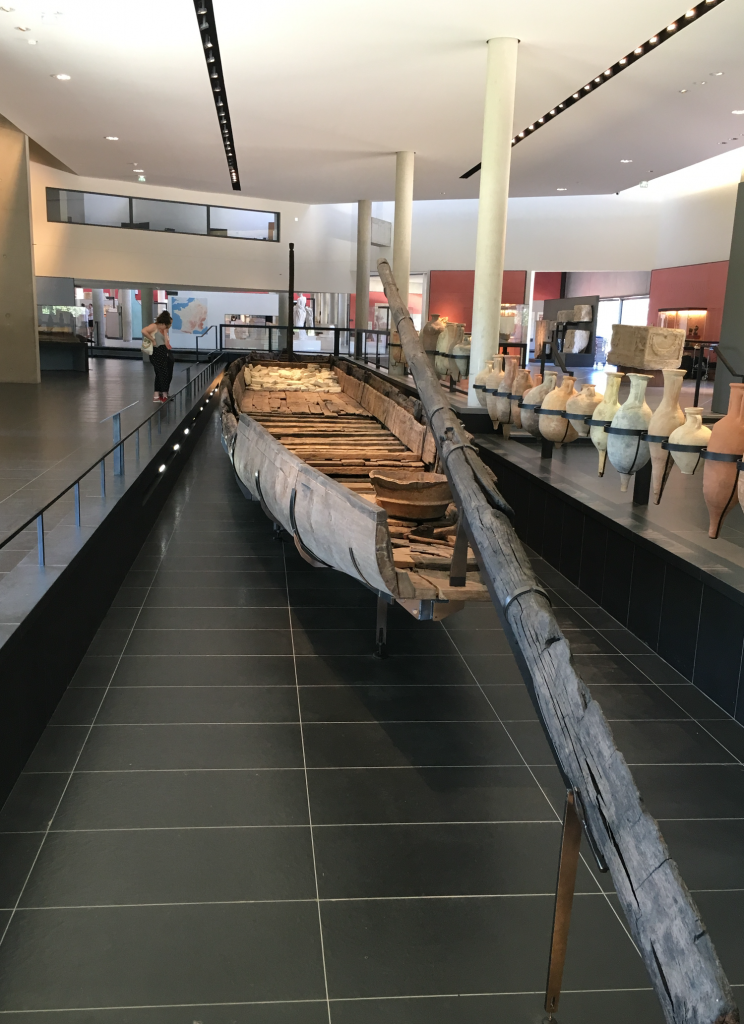The story of the Arles Rhone 3 begins in first-century Rome, in the Gallic region of Gallia Narbonensis, at the mouth of the Rhone river. The ancient Roman Empire was famous for its ships, which were used for everything from war to trade to navigation, in all of its territories. Thus it is no surprise that Roman ships, built in ancient Gaul—which, covering land from present France to Italy—used its rivers and streams to navigate and transport all manner of cargo, from sailors to tool, to building materials. More specifically, these ships were used to sail up and down the Rhone river, which ran north into the heart of Roman Gaul. The port of Arelate (modern-day Arles) bustled with trade from all parts of the Roman Empire. Roman ships like the Arles Rhone 3 would have been a common sight sailing through the waters of the Rhone river, as is still the case in the city of Arles today. And it was one of these ships that bore Gallic and Roman qualities that would ultimately find itself lost beneath the banks of the Rhone for more than 1900 years. Just how and why the ship sank when it did and where it did is still a mystery. But in the first years of the current millennia, that Roman ship, unmoved for almost two thousand years, was found in almost the same condition that it had been in when it sailed above the waves in the ancient Roman Empire.
In 2004, an archeological expedition conducted beneath the banks of the Rhone River in Arles, France, revealed a historical marvel hidden in plain sight, a Gallo-Roman ship that would come to be known as the Arles Rhone 3, which was discovered a few meters beneath the surface of the river bed. Study of the Arles Rhone 3 allowed researchers to understand that the ship, a flat-bottomed barge measuring more than 100 feet (31 meter) long, was seemingly perfectly preserved, just as it must have been before it sank, surrounded by ceramics and carrying cargo, besides the obvious furniture, that not only added to the air of mystery about it, but also appeared to identify it as a trading vessel.1 Despite this, however, the unconventional location of the barge meant that examining it properly would be extremely difficult, and that recovering it would be even more so.

The recovery of the Arles Rhone 3 was a very delicate and thorough process. The lack of visibility underwater meant that seeing where the barge was, even with its considerable size factored in, was a challenge that required incredible care and multiple considerations, such as specialized equipment.2 More worryingly, the completely submerged nature of the Arles Rhone 3 with its multitude of possible issues—from the unseen potential damage that arose from being buried beneath sediment, to the current of the Rhone continually wearing on the wood of the ship—meant that while time was unquestionably of the essence, the Gallo-Roman ship was also uncharted territory, with very few previous cases like it to draw upon for a recovery strategy; so erring on the side of caution was deemed the best course of action. The actual recovery began with the removal of the enormous amount of sediment and other objects, including the ship’s own cargo, that covered the barge nearly as much as the water did, with there being as much as three-meters worth coating the boat. To achieve this, the top of the boat was first cleared of sediment and other debris so that it could be unburdened, and trenches between 20 and 50 meters were dug to the left and the right of the ship in order to shift the layers of sediment and allow the boat more room to be moved freely.3 The ship was then cut into sections of roughly 3-4 meters each, ten in total, and each of these sections had “cradles” for attachment to a platform constructed around them, all done by hand, underwater. Once this was completed, the sections were lifted out of the water one by one, and even afterwards required constant attention from the land teams so that they could be kept reasonably humid, as the wood was extremely fragile and would not be able to survive drying at normal speed after having been submerged in water for so long.

The Arles Rhone 3 is incredible, not only for its own uniquely whole preservation, but also for the preservation of what it carried with it. Ceramics, amorphae, and other cargo, including, coins, iron, bronze, and even ivory were all discovered in and around the barge, and much of it was perfectly preserved, with some, such as lamps or pottery, having intricate designs, the likes of which had never before been so clearly seen or associated with the Romans or the Gauls.4 Of course, one small obstacle in salvaging the barge was the sheer number of artifacts that were retrieved with it, all of which were just as old as the Arles Rhone 3 itself, and had been submerged for the same amount of time. This meant that categorizing and organizing them took nearly as long as retrieving the barge itself, and that for some of the more delicate artifacts, prioritizing them was key. Despite this, however, when all was said and done, the picture painted by these items is often considered another avenue through which to examine the culture of both societies, Roman and Gallic, and any aspects of culture that may have resulted from their cultural syncretism.
With the incredible amount of time and effort needed to retrieve the Arles Rhone 3 and catalogue its treasure trove of artifacts, it is even more impressive that the archeological and diving teams deployed to recover the wreck were retrieving one of the ten sections of the barge every week. This, of course, was a necessity, as the teams had no way of knowing how long the wood would survive and needed to have as many pieces as possible to study together.5 The race against time, while most likely exhausting, also allowed the Arles Rhone 3 to be recovered with increased efficacy, with the diving team cutting the ship, constructing the lift cradles, lifting it, at the same time that the archeological team examined and documented the retrieved barge sections above the water, which in turn led to numbering and digitally reconstructing the ship in order to be able to full physically reconstruct the ship properly.6 This sense of urgency proved well-founded, as, just as the restorative team was preparing to reconstruct the ship fully, it was discovered that the wood of the ship had dried and warped, losing its shape, and, potentially, preventing it from being reconstructed properly.7 This setback might have completely destroyed any chance of the ship ever being whole again, and might have caused the work of the teams to have been for naught. But thankfully, with the work of the restoring team and the use of carpentry to recreate any pieces that may have been too fragile or warped, the barge was reconstructed, the front half completed first, and sent to the Ancient Arles Museum in Provence, France, and the second half completed under much the same circumstances, but in Grenoble.
After months of work, with the diving team and the archeological team working tirelessly in tandem, and completely alone, to recover the Arles Rhone 3 and its cargo, the trading ship was fully retrieved, and despite complications, it was constructed as a whole ship above water for the first time, transported to the Arles Antique Departmental Museum, and then again, carefully reconstructed just as it had been previously by the restorative workers. In 2013, two years after the project to recover the lost ship, and the same year that the creation of a new wing in which to house the exhibit for the ship and its contents was announced and completed, the Arles Rhone 3 was unveiled in the Arles Antique Departmental Museum, where it continues to proudly stand to this day, a once in a lifetime discovery, a treasure trove of priceless artifacts, and one of, if not the most important and compelling looks into Gallo-Roman culture and trade that there is available to historians and archeologists alike in the modern day.

- “Arles Rhone 3 – Episode 1 – The Mysteries of the Rhone,” video file, 2:35. Vimeo, posted by Kaleo Productions, 2012. https://vimeopro.com/kaleoprod/arles-rhone-3-english/video/70102358. ↵
- ““Arles Rhone 3 – Episode 5 – Working in the Shadows” video file, 2:15. Vimeo, posted by Kaleo Productions, 2012. https://vimeopro.com/kaleoprod/arles-rhone-3-english/video/70178905. ↵
- “Arles Rhone 3 – episode 2 – The raising operation,” video file, 0:50. YouTube, Posted by AR3TV, February 14, 2012. https://www.youtube.com/watch?v=1rNbCfDBnNo. ↵
- “Arles Rhone 3 – Episode 3 – The Secret of the Ceramics,” video file, 4:38. Vimeo, posted by Kaleo Productions, 2012. https://vimeopro.com/kaleoprod/arles-rhone-3-english/video/70127149. ↵
- “Arles Rhone 3 – Episode 4 – Renaissance of a Shipwreck,” video file, 4:58. Vimeo, posted by Kaleo Productions, 2012. https://vimeopro.com/kaleoprod/arles-rhone-3-english/video/70190023. ↵
- Sabrina Marlier, Pierre Poveda, Nicolas Ranchin, “The Arles-Rhône 3 project : From the excavation and raising of a Gallo-Roman barge, in the southern coastal French city of Arles, to its documentation and modelling in 3D (2011-2012),” 13th International Symposium on Boat and Ship Archaeology, Oct 2012, 383-389. https://halshs.archives-ouvertes.fr/halshs-01807685/document. ↵
- “Arles Rhone 3 – 20 Minutes,” video file 15:28. Vimeo, posted by Kaleo Productions, 2020. https://vimeopro.com/kaleoprod/arles-rhone-3-english/video/402854294. ↵



3 comments
Christian Anthony
I did not know the Roman Empire was famous for their ships, but to be able to sail in such shallow waters is impressive nonetheless. It is also very interesting how no one knows why exactly the ship sank and it remains a mystery, perhaps the weight distribution was off but even today no one knows and its a very interesting mystery.
Karla Fabian
Before reading this article, I had little prior knowledge about ships and the Roman Empire ships. Also, it was fascinating to acknowledge that archeologists were able to recover Arles Rhone 3, even though it was built many, many years ago. Also, it was very intriguing to see that not only the ship was recovered but also over materials that give insight into the life of the Roman Empire. These things included ceramics, amorphae, coins, iron, bronze, ivory. It is essential to acknowledge that discoveries like this type can give an insight into the Gallo-Roman culture and help us comprehend what it was like to live in that era.
Ian Mcewen
I sometimes wonder what do ships need to move through rivers, I know that it is possible but most rivers I have seen are to shallow so it is harder for me imagine it. the vessel was a trade ship that moved through rivers and traded with towns along the river. trade was one of the main reasons along with easy access to water that the most successful cities have started along a river or near the sea.